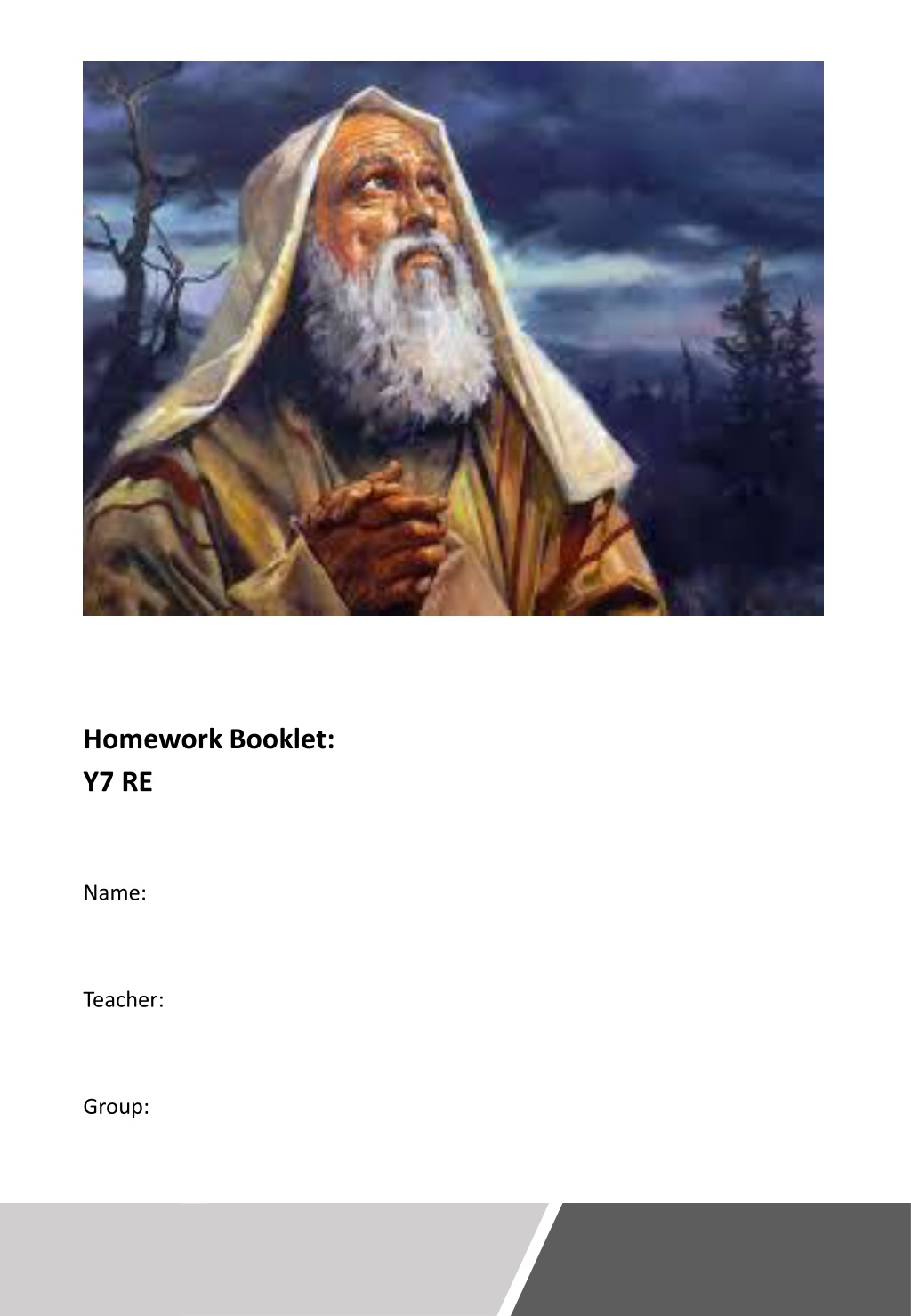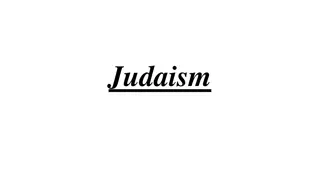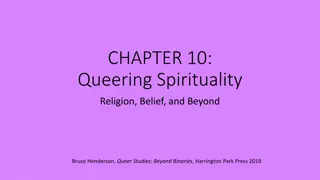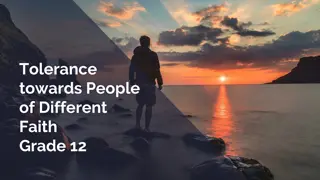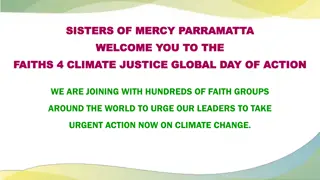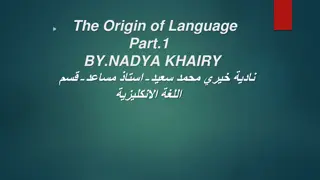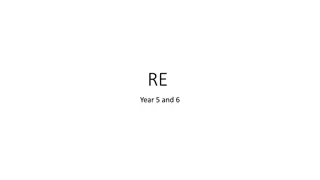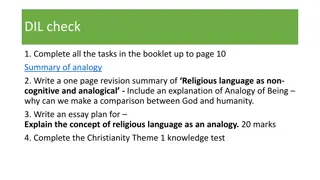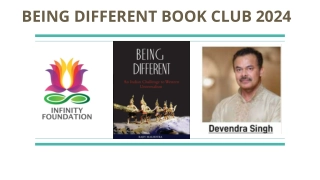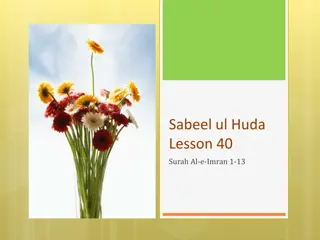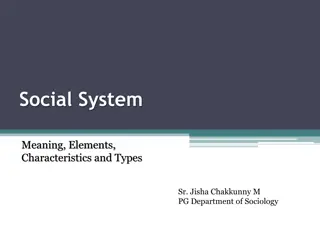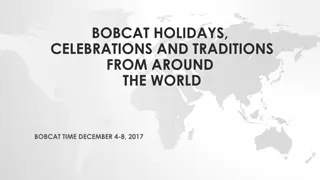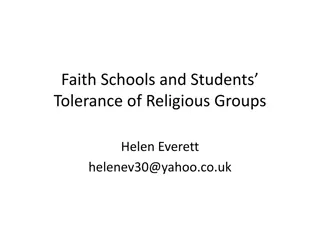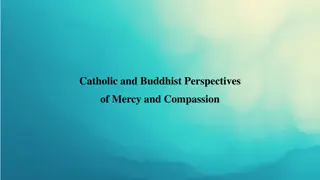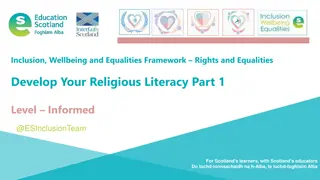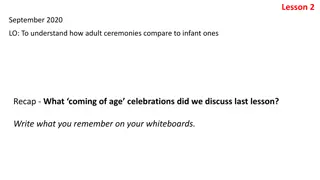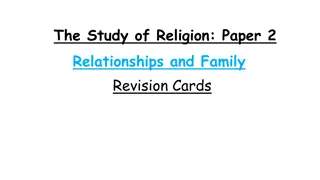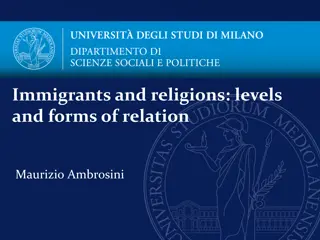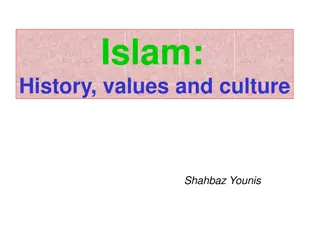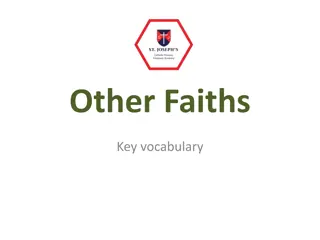Understanding the Origins of Abrahamic Faiths
Explore the key concepts and knowledge related to the origins of Judaism, Christianity, and Islam through tasks focusing on key words, key knowledge outcomes, and comprehension of Genesis. Topics covered include the common founder, key events, beliefs, and influences of these faiths.
Download Presentation

Please find below an Image/Link to download the presentation.
The content on the website is provided AS IS for your information and personal use only. It may not be sold, licensed, or shared on other websites without obtaining consent from the author. Download presentation by click this link. If you encounter any issues during the download, it is possible that the publisher has removed the file from their server.
E N D
Presentation Transcript
Homework Booklet: Y7 RE Name: Teacher: Group:
Origins of Abrahamic Faiths Homework 1: Key words Due: Knowledge Organiser| Origins of Abrahamic Faith 1 Task: Use look, cover, write, check for these 10 key words. Follow these instructions to ensure the perfect standard: 1. Write the title of the subject and the day s date in your home learning book and underline with a ruler Genesis The first book of the Jewish and Christian scriptures. 2 Adam and Eve According to Genesis, they were the first human beings created by God. 2. Write the sub-title of the section of the KO that you are focusing on and underline with a ruler 3 The hero of the biblical flood story in the book of Genesis. Noah 3. Write out the key words you have been told to do with two spaces in between each one 4 God's decision to return the Earth to its pre-creation state of watery chaos and then remake it in a reversal of creation. The Flood 4. Focus on just one key term and cover the others 5 Abraham (Ibrahim in Islam) The common founder of Judaism, Christianity and Islam. 5. Read the definition of the first key word in your head 6. Now cover it up and say it back to yourself 6 Covenan t Conditional promises made to humanity by God. 7. Uncover the definition and check you said it correctly 8. Repeat this stage with the rest of the definitions 7 An act of slaughtering an animal or person or surrendering a possession as an offering to a deity. Sacrifice 9. Now cover all the definitions and write them all out from memory 8 Abraham s son who went on to be ancestor to the Jewish people. 10. Uncover the definitions and using a green pen correct any mistakes you may have made Isaac REPEAT UNTIL YOU ARE WORD PERFECT! 9 Abraham s son who went on to be ancestor to the Muslim people. Ishmael 10 Mecca Holy city for Muslims established by Ibrahim and Ishmael.
Origins of Abrahamic Faiths Homework 2: Knowledge Outcomes Due: Questions Answers Who is the common founder of Judaism, Christianity and Islam? Abraham. Task: Use look, cover, write, check for these 10 knowledge outcomes. Follow these instructions to ensure the perfect standard: 1. Write the title of the subject and the day s date in your home learning book and underline with a ruler What is monotheism? The belief in one God. What is polytheism? The belief in more than one God. 2. Read through all 10 questions and answers. What is a covenant? A promise or an agreement. 3. Cover up the answers and answer the questions. What is the first book of the Torah and Bible? Genesis. 4. Uncover the answers and in green pen mark your work. 5. Any that you got wrong, look back over the answers and repeat the process until you have 10/10. What happened in Genesis 3? Original Sin. What happened to Adam and Eve after they disobeyed God? They were exiled from the Garden of Eden. What happened to the relationship between God and humans after this? The relationship was broken, humans and God were separated. What has religion influenced? Art, literature, architecture, and law. Define omnibenevolent. All loving.
Origins of Abrahamic Faiths Homework 3: Comprehension Due: Genesis is the first book of the Bible. It is divided into three parts. Genesis 1 describes the creation of Heaven and Earth. Genesis 2 focuses on the creation of the first humans, Adam and Eve. In Genesis 3, Christians learn how Adam and Eve disobeyed God and brought sin into the world. Genesis 1 explains how: God is the only creator. God existed before he created the world. The world was well planned and is sustained by God. God blessed creation, which means that all creation is holy. God created everything in Heaven and on Earth in six days. On the seventh day, God rested. The Bible teaches Christians that God created humans in his image: So, God created mankind in his own image, in the image of God he created them; male and female he created them. (Genesis 1:27). This does not mean that humans physically have the same appearance as God. Instead, they have certain characteristics that they share with God, such as being loving. For Christians, this shows how important all humans are to God and explains their special relationship with him. It is also a reminder to them that humans should try to show love and forgiveness just as God does. According to Christian belief, sin separates humans from God, bringing lasting punishment and preventing salvation. God gave humans free will, so it is up to each person to decide for themselves whether to do good or evil. Only God can solve the problem of humans often choosing to sin. To do this, he offered salvation through the sacrifice of Jesus Christ. Original Sin Genesis 3 tells the story of how sin first entered the world when Adam and Eve were tempted by the Devil in the Garden of Eden. They ate an apple from the Tree of Knowledge after God had instructed them not to, and as a result they were banished. Evil had now entered the world - this is known as the Fall. The sinfulness of Adam and Eve caused a separation from God that could have resulted in humanity s eternal punishment. Some Christians believe that all humans are descendants of Adam and Eve. If this is true, then all humans are connected to this first act of disobedience against God, known as Original Sin. Many Christians believe that every person is born with an inherited trace of Original Sin, which means that everyone has the ability, or even an urge, to disobey God. Christianity teaches that God has given humanity the opportunity for salvation from sin through the incarnation and sacrifice of Jesus, the Son of God. The idea of sacrificing an animal or sending it out into the wilderness to make up for the sin of humans is unfamiliar to us today. However, at the time of Jesus, it was well understood as an important part of religious practice. For Christians, Jesus sacrifice means that, through faith and good works, human souls can be saved from eternal punishment (or separation from God). They can enter Heaven (where they will be in the presence of God). Task: In full sentences, answer the following questions: 1. What does Genesis 1 explain? 2. What does it mean to say humans are made in God s image ? 3. What is free will? 4. What happens in Genesis 3? 5. What happened as a result of Jesus sacrifice?
Origins of Abrahamic Faiths Homework 4: Knowledge Outcomes Due: Questions Answers Who are Abraham s two sons? Ishmael and Isaac. Task: Use look, cover, write, check for these 10 knowledge outcomes. Follow these instructions to ensure the perfect standard: 1. Write the title of the subject and the day s date in your home learning book and underline with a ruler What is monotheism? The belief in one God. What is a sacrifice? An act of slaughtering an animal or person as an offering to a god. What is a covenant? A promise or an agreement. 2. Read through all 10 questions and answers. Why did God make a covenant with Abraham. Abraham smashed his father s idols to show he was willing to accept God as the only one. 3. Cover up the answers and answer the questions. 4. Uncover the answers and in green pen mark your work. What was the name of Abraham s wife? Sarai / Sarah. 5. Any that you got wrong, look back over the answers and repeat the process until you have 10/10. How long did God send down the rain once Noah had built his ark? 40 days and 40 nights. How old was Abraham according to Genesis? 600 years old. Why is age important in the Old Testament. Old age shows greater importance. Define omniscient. All knowing.
Origins of Abrahamic Faiths Homework 5: Seneca Due: Task: Your teacher has set up a Seneca quiz (1.1-1.4). Please head to Teams to access the quiz by clicking on the link. This should take you 20-30 minutes. If you have any issues logging on to Teams or Seneca, please contact your teacher(s), IT or Head of Year immediately.
Origins of Abrahamic Faiths Homework 6: Comprehension Due: Why did God flood the world? The story of the flood is found in Genesis, but it really begins a bit earlier. We can t forget that this story is part of a larger literary unit. After Adam and Eve ate the fruit of the tree of the knowledge of good and evil. 1Now the serpent was more crafty than any beast of the field which the Lord God had made. And he said to the woman, Indeed, has God said, You shall not eat from any tree of the garden ? 2The woman said to the serpent, From the fruit of the trees of the garden we may eat; 3but from the fruit of the tree which is in the middle of the garden, God has said, You shall not eat from it or touch it, or you will die. 4The serpent said to the woman, You surely will not die! 5For God knows that in the day you eat from it your eyes will be opened, and you will be like God, knowing good and evil. 6When the woman saw that the tree was good for food, and that it was a delight to the eyes, and that the tree was desirable to make one wise, she took from its fruit and ate; and she gave also to her husband with her, and he ate. 7Then the eyes of both of them were opened, and they knew that they were naked; and they sewed fig leaves together and made themselves loin coverings. 8They heard the sound of the Lord God walking in the garden in the cool of the day, and the man and his wife hid themselves from the presence of the Lord God among the trees of the garden. 9Then the Lord God called to the man, and said to him, Where are you? 10He said, I heard the sound of You in the garden, and I was afraid because I was naked; so I hid myself. 11And He said, Who told you that you were naked? Have you eaten from the tree of which I commanded you not to eat? 12The man said, The woman whom You gave to be with me, she gave me from the tree, and I ate. 13Then the Lord God said to the woman, What is this you have done? And the woman said, The serpent deceived me, and I ate. ) Things began a downward spiral. Humanity multiplied and violence reigned. Cain killed his brother Abel. One of Cain s descendants, Lamech, became a man renowned for violence, boasting his exploits). Sin and evil were only intensifying. How would God react to this state of humanity? Just before the story of the flood begins, we learn that the Lord saw that the wickedness of man was great in the earth, and that every intention of the thoughts of his heart was only evil continually and it grieved God to his heart . So God sent the floodwaters as a judgment, a block in the way of humanity s wickedness that rose out of the grief of his heart. Genesis describes the flood as the de-creation of the world the earth sinks back into the chaotic waters that God cleared away on page one of the Bible. In the ark, God carries Noah s family through the flood unharmed to start afresh in a world returned to innocence. It is a new beginning and a chance to have a different end. If you re like us, you might be saying, But no matter how you tell the story, God still wipes out all of humanity except one family! How does the flood reflect the goodness of God when he sent such disaster on the earth? Let s make three observations from the context of the story. Just Mercy The story of the flood is one of God taking merciful action to restrain humanity s ever-increasing evil. Genesis tells us that God saw that every intention of the thoughts of man s heart was only evil continually . In the Bible, context means everything. Genesis firmly anchors the meaning of the flood in the context of God s intervention to stop humanity s headlong slide into evil. Grief, Not Vengeance God doesn t take pleasure in the flood. Rather, Genesis highlights how the wickedness unleashed by the Fall caused him sorrow and grief. God made the earth to be a place where humanity could flourish, but instead they turned it into a theater of violence and disaster. And God s heart was broken. Covenant Later on, when Isaiah the prophet remembers Noah, he doesn t think of the flood but the covenant God made with Noah afterward. In that covenant, God promises that nothing like this will ever happen again. This points to the key meaning of the story: the flood is about God s mercy and commitment to the goodness of what he has made. A New Beginning? So what have we learned so far? The flood wasn t an act of destruction by a angry God. God was acting to restore the goodness of his creation. God preserves one family through the flood and elevates Noah as a new Adam, placed once again in a garden on a high mountain paradise with the commission to be fruitful and multiply. Of course, just as in Eden, instead of spreading God s goodness, Noah and his family begin again to spread the disaster of human evil. Answer these questions in full sentences: 1. Explain what happened in Genesis 3? 2. According to the author, why should God not be seen as violent and out of order? Give two reasons. 3. How could it be argued that God s covenant with Noah failed?
Origins of Abrahamic Faiths Homework 7: Key words Due: Knowledge Organiser| Origins of Abrahamic Faith 11 The Hebrew prophet who led the Israelites out of Egypt and delivered the Law during their years of wandering in the wilderness. Task: Use look, cover, write, check for these 10 key words. Follow these instructions to ensure the perfect standard: 1. Write the title of the subject and the day s date in your home learning book and underline with a ruler Moses 12 Second book of the Jewish and Christian scriptures which tells the story of Moses and the Israelites. Exodus 2. Write the sub-title of the section of the KO that you are focusing on and underline with a ruler 13 Third book of the Jewish and Christian scriptures which contains laws and ceremonial practices. Leviticus 3. Write out the key words you have been told to do with two spaces in between each one 14 Day of Atonement A religious practice described in Leviticus to remove the sins of the community. 4. Focus on just one key term and cover the others 5. Read the definition of the first key word in your head 15 First-century Jewish teacher who Christians believe to be the Son of God. Jesus 6. Now cover it up and say it back to yourself 7. Uncover the definition and check you said it correctly 16 An ancient Jewish group, distinguished by strict observance of the traditional and written law. Pharisees 8. Repeat this stage with the rest of the definitions 9. Now cover all the definitions and write them all out from memory 17 An ancient form of execution in which a person was nailed or bound to a cross. Crucifixion 10. Uncover the definitions and using a green pen correct any mistakes you may have made 18 Saving from sin and its consequences, believed by Christians to be brought about by faith in Jesus. Salvation REPEAT UNTIL YOU ARE WORD PERFECT! 19 Polytheism The belief in more than one god. 20 Monotheism The belief in one God.
Origins of Abrahamic Faiths Homework 8: Seneca Due: Task: Your teacher has set up a Seneca quiz (1.5-1.7). Please head to Teams to access the quiz by clicking on the link. This should take you 20-30 minutes. If you have any issues logging on to Teams or Seneca, please contact your teacher(s), IT or Head of Year immediately.
Origins of Abrahamic Faiths Homework 9: 10 Commandments Due: TASK: Read through the list of the Ten Commandments. Select the commandment you think is most important and explain in your own words why it is the most important. Then do the same with the least important commandment. The Ten Commandments 1. I am the Lord your God, you shall have no other Gods before me 2. You shall not worship false Gods 3. You shall never take my name in vain 4. You shall keep the sabbath day Holy 5. Honor your Father and Mother 6. You shall not murder 7. You shall not commit adultery 8. You shall not steal 9. You shall not lie 10. You shall never want what belongs to others Most important commandment: Why do you think this commandment is most important? Least important commandment: Why do you think this commandment is least important?
Origins of Abrahamic Faiths Homework 10: Seneca Due: Task: Your teacher has set up a Seneca quiz (1.7-1.10). Please head to Teams to access the quiz by clicking on the link. This should take you 20-30 minutes. If you have any issues logging on to Teams or Seneca, please contact your teacher(s), IT or Head of Year immediately.
Judaism Homework 1: Key words Due: Knowledge Organiser| Origins of Abrahamic Faith An ethnic religion made up of the collective religious, cultural, and legal tradition and civilization of the Jewish people. 1 Task: Use look, cover, write, check for these 10 key words. Follow these instructions to ensure the perfect standard: 1. Write the title of the subject and the day s date in your home learning book and underline with a ruler Judaism 2 Monotheism The belief in one God. 2. Write the sub-title of the section of the KO that you are focusing on and underline with a ruler The law of God as revealed to Moses and recorded in the first five books of the Hebrew scriptures. 3 Torah 3. Write out the key words you have been told to do with two spaces in between each one The Jewish Scriptures comprising the books of law, the prophets, and collected writings. 4 Tanakh 4. Focus on just one key term and cover the others The body of Jewish civil and ceremonial law and legend. 5 5. Read the definition of the first key word in your head Talmud 6. Now cover it up and say it back to yourself Orthodox Judaism A major branch within Judaism which teaches strict following of Jewish law and its traditional observances. 6 7. Uncover the definition and check you said it correctly 8. Repeat this stage with the rest of the definitions Reform Judaism A branch of Judaism which has reformed or abandoned aspects of Orthodox Jewish worship and ritual in an attempt to adapt to modern life. 7 9. Now cover all the definitions and write them all out from memory 10. Uncover the definitions and using a green pen correct any mistakes you may have made 8 Synagogue A Jewish place of worship. REPEAT UNTIL YOU ARE WORD PERFECT! The Western Wall The holiest site where Jews are allowed to pray, behind it lies the foundation stone. 9 The In traditional Jewish sources, it is considered the place from which the creation of the world began. 1 0 Foundation Stone
Judaism Homework 2: Comprehension TASK: Complete the reading then answer the questions on the other side of this sheet. The Jewish covenant What is a covenant? The word covenant means agreement, such as a contract between two people. Jews see their relationship with God as a covenant, or an agreement. They believe that God asks them to do certain things, and in return he will take special care of them. The first covenant began between God and the founder of the Jewish people, Abraham. Abraham was the first person to introduce the idea of monotheism, or the belief in only one God. Before this people worshipped many gods, this form of religion is known as polytheism. Abraham was originally known as Abram, but was renamed Abraham by God which means father of many nations . The Abrahamic covenant The covenant between Abraham and God consisted of three separate parts: the promised land the promise of the descendants the promise of blessing and redemption The promised land The first part of the covenant is known as the promised land and can be found in Genesis 12:1, where Abraham is called by God to leave Ur and go to a place known as Canaan. The land of Canaan then became known as Israel. Israel was named after Abraham's grandson and is often referred to as the promised land because God promised to give the land to the descendants of Abraham. The promise of the descendants The second part of the covenant is known as the promise of the descendants and can be found in Genesis 12:2. This is where God promised Abraham that he would make a great nation out of him I will increase your numbers very, very much, and I will make you into nations.... This is when God changed Abram s name to Abraham meaning father of many nations . The promise of blessing and redemption The third and last part of the Abrahamic covenant is known as the promise of blessing and redemption. It can be found in Genesis 12:1-3, where God promises to bless Abraham and all of his descendants.
Question Answer What is a covenant? What was the main religion that people had before Abraham? Why did God change Abraham s name from Abram to Abraham? What does the name Abraham mean? What land is Abraham called to leave and where does he go? What did the land of Canaan become known as? What book, chapter and verse can the promise of the descendants be found?
Judaism Homework 3: Knowledge Outcomes Due: Questions Answers Who is the common founder of Judaism, Christianity and Islam? Abraham. Task: Use look, cover, write, check for these 10 knowledge outcomes. Follow these instructions to ensure the perfect standard: 1. Write the title of the subject and the day s date in your home learning book and underline with a ruler What is monotheism? The belief in one God. What must someone be in order to be Jewish? A descendant of Abraham. 2. Read through all 10 questions and answers. 3. Cover up the answers and answer the questions. What is a covenant? A promise or an agreement. 4. Uncover the answers and in green pen mark your work. What percentage of the world s population is Jewish? 0.18% 5. Any that you got wrong, look back over the answers and repeat the process until you have 10/10. Where do Jews get the law to live by from? The Torah. How many mitzvot are there in the Torah? 613 What are the most important mitzvot? The 10 commandments. What are the two main types of Jew? Orthodox and Reform. What are the three main beliefs in Judaism? 1. Belief in one God. They are a family as descendants of Abraham. God made a covenant with them. 2. 3.
Judaism Homework 4: Comprehension Due: More than three thousand years ago, Pharaoh Ramses II ruled over Egypt. One of Pharaoh's closest friends Moses, who had been brought up by a princess as her own son. But Moses was a Hebrew, not an Egyptian, and his people were slaves under Ramses II. One day Moses saw an Egyptian soldier beating a Hebrew slave, and he was so angry that he killed the Egyptian. Moses then fled to Midian, where he lived for many years as a shepherd. One day, while tending his flock, Moses saw a burning bush. The bush was ablaze with fire but remained unharmed. Moses understood that God was calling him to save the Hebrews from slavery. Moses didn t know how he would lead his people out of Egypt, but God promised Moses that He would help him. Moses begged the Pharaoh to let his people go, but he refused. Then he performed a miracle! Aaron threw his staff upon the ground and the staff turned into a snake. Sadly, Ramses refused to let the Hebrews go. The next morning, as the Pharaoh was walking by the river Nile, Moses and Aaron again asked him to let their people go. When Ramses refused, Aaron struck the Nile with his staff and turned the river into blood, so no one could drink from it. But Ramses remained unconvinced and still refused to let the Hebrews go. God then sent nine plagues to Egypt, each worse than the earlier. With every plague, Ramses would be afraid, and promise to let the Hebrews go. But as soon as God would lift the plague, he would go back on his word and refuse the Hebrews their freedom once again. Then God sent one final, terrible plague to the land of Egypt. He sent his Angel of Death to visit every single household in Egypt, and take away the firstborn child. But Moses had warned the Hebrews, and told them to mark their doors with a special sign. So, that night, when the Angel of Death came to Egypt, he passed over the houses with the special sign, and spared the firstborn of the Hebrews. This was the beginning of the Passover, the Jewish festival that celebrates the 'passing over' of the Angel of Death, and the sparing of the firstborn of the Israelites. But the Angel of Death did not spare a single Egyptian family that night, and took even the Pharaoh's son. In despair the Pharaoh told Moses to take his people and to leave Egypt forever. When the Pharaoh realised that Moses and the Israelites had actually left Egypt, he sent his army after them, to capture them and bring them back. The Pharaoh's army pursued the Israelites eastwards to the Sea of Reeds, a papyrus lake, which God enabled the Hebrews to cross safely. But the Egyptian army was engulfed by the waters of the lake and each and every Egyptian soldier perished. Moses then led his people to Mt. Sinai, where Yahweh again revealed himself to Moses. Out of this revelation came the Covenant between Yahweh and the people of Israel, and the Ten Commandments. as in Eden, instead of spreading God s goodness, Noah and his family begin again to spread the disaster of human evil. Answer these questions in full sentences: 1. What was different about Moses? 2. Why did Moses kill an Egyptian soldier? 3. What sign did Moses see? 4. What miracle did Aaron perform? 5. Why did God send 9 plagues to Egypt? 6. Explain what happened with the Angel of Death
Judaism Homework 5: Seneca Due: Task: Your teacher has set up a Seneca quiz (1.1-1.4). Please head to Teams to access the quiz by clicking on the link. This should take you 20-30 minutes. If you have any issues logging on to Teams or Seneca, please contact your teacher(s), IT or Head of Year immediately.
Judaism Homework 6: Key words Due: Knowledge Organiser| Origins of Abrahamic Faith Task: Use look, cover, write, check for these 10 key words. Follow these instructions to ensure the perfect standard: 1. Write the title of the subject and the day s date in your home learning book and underline with a ruler 1 1 The Jewish day of rest. Shabbat Jewish celebration which remembers the Hebrews freedom from slavery in Egypt. Pesach (Passover) 1 2 A Jewish ritual service and ceremonial dinner for the first night or first two nights of Passover. 1 3 Seder 2. Write the sub-title of the section of the KO that you are focusing on and underline with a ruler The holiest day of the year where Jews spend most of the day in the Synagogue. Yom Kippur (Day of Atonement) 1 4 3. Write out the key words you have been told to do with two spaces in between each one Hostility to or prejudice against Jewish people. Anti- Semitism 1 5 4. Focus on just one key term and cover the others The anti-Semitic belief that the Jewish people were collectively responsible for the death of Jesus. Jewish Deicide 1 6 5. Read the definition of the first key word in your head 6. Now cover it up and say it back to yourself Hostility and ill-treatment, especially because of race or political or religious beliefs; oppression. 1 7 7. Uncover the definition and check you said it correctly Persecution 8. Repeat this stage with the rest of the definitions The deliberate killing of a large number of people from a particular nation or ethnic group with the aim of destroying that nation or group. 1 8 Genocide 9. Now cover all the definitions and write them all out from memory 10. Uncover the definitions and using a green pen correct any mistakes you may have made The genocide of European Jews during WWII, committed by the Nazis, killing six million Jewish people. Holocaust (Shoah) 1 9 REPEAT UNTIL YOU ARE WORD PERFECT! Holocaust Memorial Day is a national commemoration day in the United Kingdom dedicated to the remembrance of the Jews and others who suffered in the Holocaust, under Nazi persecution. Holocaust Memorial Day 2 0
Judaism Homework 7: Self Quizzing Complete all answers in the quiz. When all answers have been attempted, turn the page and mark your work. Be sure to add the correct answers if you did not get it first time round. Due: What is the most holy day for Jews? What part of the Torah is read during Passover? What is the Hebrew word for Passover? What is the purpose of the seder plate at Passover? Which festival is the Jewish new year? What is the day of rest known as for Jews? Name three things that cannot be done on Shabbat. What is the name of the holy building for Jews? In the synagogue, what is the Aron Hakodesh? In the synagogue, what is the Ner Tamid?
Answers: Use green pen to correct and mark your answers. What is the most holy day for Jews? Yom Kippur What part of the Torah is read during Passover? Exodus What is the Hebrew word for Passover? Peseach What is the purpose of the seder plate at Passover? Remind Jews of their bitter past e.g. slavery Which festival is the Jewish new year? Rosh Hashana What is the day of rest known as for Jews? Shabbat Name three things that cannot be done on Shabbat. Handling money, using electricity, using motored vehicles, doing homework, going to work. What is the name of the holy building for Jews? Synagogue In the synagogue, what is the Aron Hakodesh? The ark in the synagogue where the Torah scrolls are kept In the synagogue, what is the Ner Tamid? The light that hangs above the Aron Hakodesh
Judaism Homework 8: Self Quizzing Complete all answers in the quiz. When all answers have been attempted, turn the page and mark your work. Be sure to add the correct answers if you did not get it first time round. Due: Who did Moses free from slavery? What is the first book the Torah / Bible? Which prophet destroyed his father s idols and established the monotheistic faiths? Who do Jews leave the door open and a glass of wine for during Pesach? What is the name of all the Jewish scriptures together? What is a covenant? How are Orthodox and Reform Jews different? Which part of the Torah gives Jews their laws or rules? What is the name of the Torah that is kept in and used in the synagogue? In the synagogue, what is the Bimah?
Answers: Use green pen to correct and mark your answers. Who did Moses free from slavery? Israelites What is the first book the Torah / Bible? Genesis Which prophet destroyed his father s idols and established the monotheistic faiths? Abraham Who do Jews leave the door open and a glass of wine for during Pesach? Elijah What is the name of all the Jewish scriptures together? Tanakh What is a covenant? A promise or an agreement How are Orthodox and Reform Jews different? Orthodox Jews live by the rules exactly as stated in the Torah. Reform Jews have adapted to fit better in the modern day Which part of the Torah gives Jews their laws or rules? Leviticus What is the name of the Torah that is kept in and used in the synagogue? Sefer Torah In the synagogue, what is the Bimah? A raised stand or platform in the synagogue for readings
Judaism Homework 10: Self Quizzing Complete all answers in the quiz. When all answers have been attempted, turn the page and mark your work. Be sure to add the correct answers if you did not get it first time round. Due: What is the most holy day for Jews? What part of the Torah is read during Passover? What is the Hebrew word for Passover? What is the purpose of the seder plate at Passover? Which festival is the Jewish new year? What is the name of all the Jewish scriptures together? What is the name of the Torah that is kept in and used in the synagogue? In the synagogue, what is the Bimah? In the synagogue, what is the Aron Hakodesh? In the synagogue, what is the Ner Tamid?
Answers: Use green pen to correct and mark your answers. What is the most holy day for Jews? Yom Kippur What part of the Torah is read during Passover? Exodus What is the Hebrew word for Passover? Peseach What is the purpose of the seder plate at Passover? Remind Jews of their bitter past e.g. slavery Which festival is the Jewish new year? Rosh Hashana What is the name of all the Jewish scriptures together? Tanakh What is the name of the Torah that is kept in and used in the synagogue? Sefer Torah In the synagogue, what is the Bimah? A raised stand or platform in the synagogue for readings In the synagogue, what is the Aron Hakodesh? The ark in the synagogue where the Torah scrolls are kept In the synagogue, what is the Ner Tamid? The light that hangs above the Aron Hakodesh
Judaism Homework 10 Seneca Due: Task: Your teacher has set up a Seneca quiz (1.5-1.10). Please head to Teams to access the quiz by clicking on the link. This should take you 20-30 minutes. If you have any issues logging on to Teams or Seneca, please contact your teacher(s), IT or Head of Year immediately.
Christianity Homework 1: Key words Due: Knowledge Organiser| Origins of Abrahamic Faith The religion based on the person and teachings of Jesus Christ. 1 Task: Use look, cover, write, check for these 10 key words. Follow these instructions to ensure the perfect standard: 1. Write the title of the subject and the day s date in your home learning book and underline with a ruler Christianity First-century Jewish teacher who Christians believe to be the Son of God. 2 Jesus 2. Write the sub-title of the section of the KO that you are focusing on and underline with a ruler 3 The Nativity The birth of Jesus Christ. 3. Write out the key words you have been told to do with two spaces in between each one Immaculat e Conception The teaching that God preserved the Virgin Mary from the taint of original sin. 4 4. Focus on just one key term and cover the others A messiah is a saviour or liberator of a group of people. Christians believe Jesus to be the Messiah. 5 Messiah 5. Read the definition of the first key word in your head 6. Now cover it up and say it back to yourself 6 Ministry The work of a religious person. 7. Uncover the definition and check you said it correctly Sermon on the Mount A collection of sayings and teachings attributed to Jesus Christ, which emphasises his moral teaching. 7 8. Repeat this stage with the rest of the definitions 9. Now cover all the definitions and write them all out from memory The blessings listed by Jesus in the Sermon on the Mount. 8 10. Uncover the definitions and using a green pen correct any mistakes you may have made Beatitudes The final meal that Jesus shared with his disciples before his crucifixion. 9 REPEAT UNTIL YOU ARE WORD PERFECT! Last Supper The Christian service commemorating the Last Supper, in which bread and wine are consecrated and consumed. 10 Eucharist
Christianity Homework 2: Comprehension Due: Mark 6:30 Mark 6:30- -44 Jesus Feeds the Five Thousand Jesus Feeds the Five Thousand 44New International Version (NIV) H/W 1 New International Version (NIV) H/W 1 30The apostles gathered around Jesus and reported to him all they had done and taught.31Then, because so many people were coming and going that they did not even have a chance to eat, he said to them, Come with me by yourselves to a quiet place and get some rest. 32So they went away by themselves in a boat to a solitary place.33But many who saw them leaving recognized them and ran on foot from all the towns and got there ahead of them.34When Jesus landed and saw a large crowd, he had compassion on them, because they were like sheep without a shepherd. So he began teaching them many things. 35By this time it was late in the day, so his disciples came to him. This is a remote place, they said, and it s already very late.36Send the people away so that they can go to the surrounding countryside and villages and buy themselves something to eat. 37But he answered, You give them something to eat. They said to him, That would take more than half a year s wages[a]! Are we to go and spend that much on bread and give it to them to eat? 38 How many loaves do you have? he asked. Go and see. When they found out, they said, Five and two fish. 39Then Jesus directed them to have all the people sit down in groups on the green grass.40So they sat down in groups of hundreds and fifties.41Taking the five loaves and the two fish and looking up to heaven, he gave thanks and broke the loaves. Then he gave them to his disciples to distribute to the people. He also divided the two fish among them all.42They all ate and were satisfied,43and the disciples picked up twelve basketfuls of broken pieces of bread and fish.44The number of the men who had eaten was five thousand. Questions: 1) Who are the people involved in the miracle? 2) Explain what happens in the miracle in your own words. 3) What is the meaning behind the miracle? Explain what the meaning of it is. 4) Do you think the miracle is credible/believable? Explain your reasoning.
Christianity Homework 3: Knowledge Outcomes Due: Questions Answers What is the holy book for Christians? The Bible Task: Use look, cover, write, check for these 10 knowledge outcomes. Follow these instructions to ensure the perfect standard: 1. Write the title of the subject and the day s date in your home learning book and underline with a ruler Give an example of a miracle of Jesus. Feeding of 5000 What famous quote came from the story of Jesus and the adulterous woman. Whoever has not sinned may cast the first stone What are the three parts of Jesus ministry? Teachings Parables Miracles 2. Read through all 10 questions and answers. 3. Cover up the answers and answer the questions. What is the birth of Christ known as? The Nativity. 4. Uncover the answers and in green pen mark your work. What is a parable? A story from Jesus that gives a lesson or moral. 5. Any that you got wrong, look back over the answers and repeat the process until you have 10/10. Define ministry. The work of a religious person. What religion was Jesus? Jesus. What was the immaculate conception? The virgin Mary becoming pregnant. Where is the life of Jesus recorded in the Bible? The Gospels (New Testament).
Christianity Homework 4: Making a judgement The Life of Jesus. TASK: Pick one event from the life of Jesus and explain which one you think is the most important and why. You need to fill the lines below. The Nativity The annunciation and incarnation The Virgin Birth Jesus is visited by shepherds and kings The parable of the good Samaritan Jesus and the adulterous woman Jesus walks on water The sermon on the mount The crucifixion The resurrection
Christianity Homework 4: Comprehension Due: 3 3 In those days John the Baptist came, preaching in the wilderness of Judea2and saying, Repent, for the kingdom of heaven has come near. 3This is he who was spoken of through the prophet Isaiah: A voice of one calling in the wilderness, Prepare the way for the Lord, make straight paths for him. [a] 4John s clothes were made of camel s hair, and he had a leather belt around his waist. His food was locusts and wild honey.5People went out to him from Jerusalem and all Judea and the whole region of the Jordan.6Confessing their sins, they were baptized by him in the Jordan River. 7But when he saw many of the Pharisees and Sadducees coming to where he was baptizing, he said to them: You brood of vipers! Who warned you to flee from the coming wrath?8Produce fruit in keeping with repentance.9And do not think you can say to yourselves, We have Abraham as our father. I tell you that out of these stones God can raise up children for Abraham.10The ax is already at the root of the trees, and every tree that does not produce good fruit will be cut down and thrown into the fire. 11 I baptize you with[b]water for repentance. But after me comes one who is more powerful than I, whose sandals I am not worthy to carry. He will baptize you with[c]the Holy Spirit and fire.12His winnowing fork is in his hand, and he will clear his threshing floor, gathering his wheat into the barn and burning up the chaff with unquenchable fire. The Baptism of Jesus The Baptism of Jesus 13Then Jesus came from Galilee to the Jordan to be baptized by John.14But John tried to deter him, saying, I need to be baptized by you, and do you come to me? 15Jesus replied, Let it be so now; it is proper for us to do this to fulfill all righteousness. Then John consented. 16As soon as Jesus was baptized, he went up out of the water. At that moment heaven was opened, and he saw the Spirit of God descending like a dove and alighting on him.17And a voice from heaven said, This is my Son, whom I love; with him I am well pleased. Questions: 1) Highlight the text to find evidence of the Trinity: the father the son and the holy spirit. 2) Do you think that the story of Jesus baptism is exactly true, or are the parts about God speaking more symbolic? 3) Which part of the Holy Trinity do you think is the easiest to understand (God the Father, God the Son/Jesus, God the Holy Spirit) and why do you think this is the easiest for people to understand?
Christianity Homework 5 Seneca Due: Task: Your teacher has set up a Seneca quiz (1.1-1.4). Please head to Teams to access the quiz by clicking on the link. This should take you 20-30 minutes. If you have any issues logging on to Teams or Seneca, please contact your teacher(s), IT or Head of Year immediately.
Christianity Homework 6: Key words Due: Knowledge Organiser| Origins of Abrahamic Faith Task: Use look, cover, write, check for these 10 key words. Follow these instructions to ensure the perfect standard: 1. Write the title of the subject and the day s date in your home learning book and underline with a ruler 1 1 Resurre ction The Christian belief that Jesus rose from the dead. The ascent of Jesus Christ into heaven on the 40th day after his Resurrection. 1 2 Ascensi on 2. Write the sub-title of the section of the KO that you are focusing on and underline with a ruler Nicene Creed 1 3 A statement of Christian beliefs. 3. Write out the key words you have been told to do with two spaces in between each one The three persons of the Christian godhead; Father, Son and Holy Spirit. 1 4 Trinity 4. Focus on just one key term and cover the others The evil within all human beings, inherited from Adam and Eve. 1 5 Original Sin 5. Read the definition of the first key word in your head Saint Augusti ne A Bishop who established the concept of Original Sin. 1 6 6. Now cover it up and say it back to yourself 7. Uncover the definition and check you said it correctly A 16th-century movement for the reform of abuses in the Roman Church ending in the establishment of the Reformed and Protestant Churches. 1 7 8. Repeat this stage with the rest of the definitions Reform ation 9. Now cover all the definitions and write them all out from memory Roman Catholic A branch of Christianity whose main source of authority is the Pope and the Bible. 1 8 10. Uncover the definitions and using a green pen correct any mistakes you may have made REPEAT UNTIL YOU ARE WORD PERFECT! A branch of Christianity whose main source of authority is the Bible. 1 9 Protest ant Churches that stress the preaching of the gospel of Jesus Christ, personal conversion experiences and Scripture as the sole basis for faith. 2 0 Evangel ism
Christianity Homework 7: Comprehension Complete all answers in the quiz. When all answers have been attempted, turn the page and mark your work. Be sure to add the correct answers if you did not get it first time round. Due: What is Jesus birth known as? Name the three parts of Jesus ministry Define sermon What is the Sermon on the Mount How many days after his crucifixion did Jesus resurrect? Where was Jesus arrested? Which disciple betrayed Jesus? What was discussed at the Council of Nicaea? What was the ascension? What happened on the Road to Emmaus?
Answers: Use green pen to correct and mark your answers What is Jesus birth known as? Nativity Name the three parts of Jesus ministry Teachings Actions Miracles Define sermon A talk on a religious or moral subject What is the Sermon on the Mount Information given by Jesus on how people should behave to be with God How many days after his crucifixion did Jesus resurrect? 3 days Where was Jesus arrested? Garden of Gethsemane Which disciple betrayed Jesus? Judas What was discussed at the Council of Nicaea? The relationship between God and Jesus What was the ascension? When Jesus rose straight to Heaven 40 days after his resurrection What happened on the Road to Emmaus? Two disciples walked alongside Jesus but did not recognise him until dinner when he broke the bread
Christianity Homework 8: Knowledge Outcomes Due: Questions Answers What was decided at the Council of Nicaea? That Jesus was God. Task: Use look, cover, write, check for these 10 knowledge outcomes. Follow these instructions to ensure the perfect standard: 1. Write the title of the subject and the day s date in your home learning book and underline with a ruler What are the three parts of Trinity. Father Son Holy Spirit Which emperor converted to Christianity at this time? Constantine 2. Read through all 10 questions and answers. What is Original Sin? The first sin- Adam and Eve eating from the Tree of Knowledge 3. Cover up the answers and answer the questions. 4. Uncover the answers and in green pen mark your work. Define sin An immoral act that goes against God. 5. Any that you got wrong, look back over the answers and repeat the process until you have 10/10. Why did St Augustine come up with the idea of original sin? To explain why suffering happens. How do Christians get rid of Original Sin. Baptism. Define denomination. A branch of Christianity. Who was Martin Luther. A German monk who challenged the Catholic church. Where is the life of Jesus recorded in the Bible? The Gospels (New Testament).
Christianity Homework 9: Article / Writing Task TASK: Read the article on how the current Pope (leader of the Catholic Church) is changing the Catholic Church. Then write one PEE paragraph on the other side of the sheet answering the question: Explain how Pope Francis is challenging the Catholic Church. The first non-European pope in more than 1,200 years, Francis has differed significantly from those before him with his outspoken style and his approach to leading the Church. His comments on poverty, church reform, climate change and divorce have made headlines around the world. Here is a look at some of them. He Criticized the 'Cult of Money' Driving the World Financial System Francis emphasis on the poor was transforming how people saw him within weeks of him becoming Pope. In a speech to politicians, Francis spoke of the need for more ethics in finance. We have created new idols," he said. "The worship of the golden calf of old has found a new and heartless image in the cult of money and the dictatorship of an economy which is faceless and lacking any truly humane goal. He's Not Afraid to Criticize the Church Six months into his papacy, Pope Francis sent shock waves through the Roman Catholic Church with the publication of his remarks that the church had grown obsessed with abortion, same-sex marriage and contraception, and that he had chosen not to talk about those issues despite criticism. His comments came in a long interview in which he criticized the church for putting Church rules before love, and for prioritizing Christian laws over serving the poor and marginalized. He articulated his vision of an inclusive church, a home for all a striking contrast with his predecessor, Pope Benedict XVI, who wanted a smaller, purer church. He Could Change the Church's Stance on Divorce Francis set in motion a high-level debate about whether the church could change its view toward divorced people without altering a rule that declares marriage to be permanent (divorce is not recognised by the Catholic Church). It is a hot issue within the church. The battle lines are clear: Some high-level church officials, want the church to relax its rules. They want to give divorced Catholics a chance to more fully return to church life and receive Communion even if they have remarried. Traditionalists are pushing back fiercely, arguing that the permeance of marriage is ordered by God and therefore not up for debate. This October, bishops and other church leaders will meet for a second Vatican synod at which they will decide whether to recommend changes. The decision of whether to act, then, will be up to Francis.
Explain how Pope Francis is challenging the Catholic Church. You must write at least one PEEL paragraph.
Christianity Homework 10 Seneca Due: Task: Your teacher has set up a Seneca quiz (1.5-1.10). Please head to Teams to access the quiz by clicking on the link. This should take you 20-30 minutes. If you have any issues logging on to Teams or Seneca, please contact your teacher(s), IT or Head of Year immediately.
